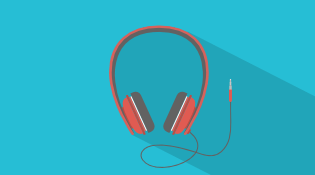
Knowing the key of a song is incredibly useful. It tells you which notes and chords you can expect in the song, which is very helpful when you’re playing, improvising, or writing music.
But how do you figure out the key of a song? In this guide, I’ll show you exactly how. We’ll discuss a few shortcuts that often work, but I’ll also show you the best way to determine the key: using your ears and musical intuition. I promise it’s easier than it sounds!
What is a key?
What does it mean when someone says a song is in the key of C minor?
Well, say we take a song and look closely at every single note used in it. That’s every single note in the guitar chords, every single note in the singer’s melodies, and so on.
Looking at all those notes, you’ll notice something striking: while there are 12 possible different notes (in Western music), the song will use only 7 of those notes, over and over again.
Together, these 7 notes make up the key of the song.
This key consists of two things:
1. The tonic or tonal centre. This is the note name, such as D, C# or Ab.
2. The tonality, such as major or minor.
For example, for the key of D minor that would be:

And for Ab:

The tonic or tonal centre is the note that all the other notes ‘revolve’ around. There’s a sort of gravity pulling all the other notes toward the tonic (aka tonal centre). The tonic sounds the most ‘at rest’ or like ‘home’. The key is named after the tonic. So, if a song is in the key of D minor, the tonic is D. And for a song in the key of Ab major, the tonic is Ab.
The tonality tells us what we need to know about the other 6 notes in the song. For example, in the key of C major, we know that we can play a C major scale. In the key of Eb minor, we can play an Eb minor scale.
In short, when someone says ‘this song is in the key of D minor’ that tells us the tonic (aka tonal centre) is D and the song will use notes from the D minor scale.
With that out of the way, let’s take a closer look at how we can find the key of a song!
We’ll discuss three methods. The first two are ‘shortcuts’ that often work, but also have some drawbacks. The third one is the best way, which is to use your ears. (Again, I’ll show you it’s easier than you might think!)
The key signature
If you have sheet music for a song or a piece of music, an easy way to find the key is to look the key signature. It's located right next to the clef.


The number of flats and sharps corresponds with certain keys.
As you can see, each key signature can be either a major key or a minor key. So you’ve narrowed down your options. How do you know which of these two it is? You listen! More about that in method 3.
Of course, there are some limitations to this method. First, you need to have written music, which we often don’t (or it takes time to look it up). Second, we still need to pick between two options (the major or minor key). And third, there are some exceptions (when we encounter ‘modal music’).
Drawbacks of this method:
- You need written music for it, which we often don’t have (or it takes time to look up).
- You still have to pick between two options (major or minor key).
- There are exceptions to this (in case of ‘modal music’, if you want to know the details)
So, we need more than this. Let’s move on to the other two methods.
The first and last chord of the song
Earlier, we saw how the tonic is the note that all the other notes revolve around. It’s like the ‘gravity’ that pulls all the other notes toward it.
In addition to the tonic note, we also have a tonic chord. This is the chord based on the tonic. So, in the key of E minor, the tonic chord is E minor. In the key of Gb major, the tonic chord is Gb major. The tonic chord is also often called the ‘one chord’ (referring to the Roman numeral system of organising chords).
Now, why is this useful?
Well, many songs start or end on the tonic chord. It gives a feeling of ‘home’ and being ‘at rest’, which is why it works well to start or finish a song on.
So for example, if a song starts and ends on a C# minor chord, there’s a good chance the song is in the key of C# minor too.
Here’s an example. This song is in the key of C# minor and it shows: it starts on it, and both the verse and the chorus end on it. Notice how it sounds more at rest whenever C#m is played.
(Sidenote: the % symbol means 'play the same thing as the last bar')
Now, unfortunately, this doesn’t always work. For example, here’s a song that does not start on the tonic chord.
To me, it feels like the song is ‘up in the air’ or ‘unresolved’ right from the start and stays like that for the longest time. Only when we reach the F chord, which is the tonic chord, does it feel ‘at rest’ or ‘at home’.
Next, here’s a song that doesn’t end on the tonic chord:
Notice how it feels a little unfinished or even unsettling? That’s because we’re not ending on the tonic chord.
Now, with these song examples, I’ve already given you a sneak peek into how we can use our gut feeling and our ears to determine the key of a song.
This is the best and most reliable way to figure out the key, so let’s take a closer look!
Finding the key of a song by ear (best way)
As we’ve seen, there are shortcuts to finding the key.
But the problem is they don’t always work and without learning how to ‘feel’ the key, you’ll never know when you’re right or not.
So a much better approach is to learn to recognise the key by ear.
Now, I realise this may sound daunting or challenging, but I promise it’s a lot easier than it sounds.
This is something that’s already inside of you.
In fact, you’ve already put in thousands of hours of practice recognising the key, without even being aware of it.
Every song you’ve ever heard plays around with notes and chords feeling ‘at home’ or not. That tension of moving back and forth from the tonic (aka tonal centre) is what makes music interesting.
In short: because of the tens of thousands of hours you’ve already listened to music, you intuitively already know this stuff.
Our goal is for you to learn to recognise that intuition and develop it so you can use it in everyday playing.
So, how exactly do we do this? How do you learn to recognise the key by ear?
I can write hundreds of words about this, but it’s faster (and more fun) to actually hear and feel what the key and the tonic feel like.
We’ll cover two exercises, Tonic Chord Selector and Tonic Drone.
TONIC CHORD SELECTOR
First, we’ll listen to a song and pick out the tonic chord. (Remember: the tonic chord will tell us what the key is.)
In the exercise below, I’ll play you a song. Below it, is a ‘disguised’ chord progression. Instead of chord names, you’ll see shapes like squares, circles and stars. (This will help you focus on what you hear, instead of thinking about theory.)
When you hit play, a blue playhead will show you what chord/shape is being played.
Now, your job is to click the shape that sounds most ‘at rest’ or ‘at home’ to you. In other words: select the tonic chord!
A few things to listen for:
- When does the song feel ‘at home’ and when is it ‘still on the road’?
- Which chord feels like it’s most ‘at rest’ or ‘at home’ to you?
- Can you imagine the song stopping on a chord? If that sounds funny, it’s probably not the tonic chord. Try pausing the song if you like.
How did it go? Hopefully it went well! Did you notice how the ‘square chord’ sounded most calm and tension-free. Like it didn’t want to anywhere. That square chord is a G major chord, so in this case the key is G major!
TONIC DRONE
Ok! Time for a different exercise.
In this one, I’ll play you a song and show you three buttons below. Each button will play a different drone note.
One of these three notes is the tonic and your mission, should you choose to accept it, is to pick which one it is!
Tip: listen to which note sounds the most calm and at rest.
Hope this one went well for you too!
Next Steps
I hope this article gave you a solid idea of what a key is in music and how to find it.
I also hope you briefly felt how you can tap into your musical intuition, which you’ve already developed over thousands of hours of music listening. Because that is the fastest and best way to figure out the key of song.
As with so many things in music, the secret to getting better is simply plenty of laser-focused practice (if possible, using real music).
Have questions about this article? Let me know, I’d love to help you out. Contact me here!


![Title image for Diatonic Chords and Harmony [Easy and Practical Guide]](https://www.stringkick.com/wp-content/uploads/2023/03/Diatonic-Chords.png)
![Title image for Learn Music Theory for Guitar [5-step Roadmap]](https://www.stringkick.com/wp-content/uploads/2022/02/Music-Theory-for-Guitar-Main.png)


